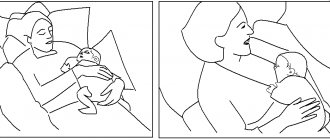Reasons for refusal
You need to understand that the causes may be different for newborns and infants, so we will consider these two separate cases.
In newborns
The following reasons are distinguished:
- If the baby immediately after birth refuses to take his mother’s breast, this may indicate stress, since for the child labor can be traumatic for the psyche.
- As for children who were born prematurely, their refusal to breastfeed may be based on underdevelopment of the sucking reflex. In addition, it may simply be difficult for such babies to suckle at the breast; they are still very weak.
- Another reason may be anatomical inaccuracies of the mammary glands. Perhaps your nipple is irregularly shaped and it is simply difficult for your baby to latch on to it. To solve this problem, you can use special attachments.
- The baby does not latch onto the breast and freaks out - this may indicate that there is not enough milk. The kid tries, makes every effort to pull out even a little more, but nothing comes of it. In this case, the mother needs to take care of increasing lactation.
- An equally rare case may be the development of lactostasis. There is a blockage of the ducts of the mammary glands. Because of this, the baby cannot get milk out. In this case, only doctors will help mommy.
Children from one month to one year
- The baby has completely adapted to a nipple or a bottle, so he doesn’t want to take his mother’s breast, since this process is more energy-consuming, and it’s much easier for a toddler to drink without putting in almost any effort.
- The likelihood of illness, the baby’s poor health.
- Perhaps you are taking the baby incorrectly, putting him to the breast in the wrong way, or the baby is simply in an uncomfortable position during feeding.
- Pain in the oral cavity. They can become both a consequence of the presence of an infectious process and teething.
- The baby may suckle at the breast and still cry if the amount of milk produced is too little or, conversely, too much. If there is not enough food, the baby will try hard to draw milk out of the breast, but nothing will work out; if there is excess fluid secretion, the baby will literally choke on it, which the toddler will obviously not like.
- Unhealthy family situation. The child is acutely aware of what is happening around him. Mom's emotions are conveyed to him best.
- Changes in the taste of breast milk due to the appearance of specific foods in the mother’s diet or as a result of taking medications by both mother and baby.
- The mammary gland is too hard. At the same time, the baby may freak out and even cry.
The reasons for breast refusal can be completely different:
It looks like a refusal, but it is not a refusal!
- The child cannot attach to the breast from birth, or takes the breast and loses it almost immediately after the start of sucking. Most likely this is due to the anatomical features of the baby or breast, the method of attachment, etc. Such a mother-baby pair needs to learn how to attach to the breast, after which the child will take and suck the breast.
- The baby is distracted during feedings and often comes off the breast. Grown-up children, usually starting from 2-3 months, become very curious and are easily distracted by the sounds, objects, people, etc. around them. Also, if a slightly older child is already full, he will not always want to suckle at the breast almost immediately after feeding, even if it is convenient or necessary for the mother.
The child is sick or feels unwell. Various diseases (eg, otitis media, stomatitis, runny nose, sore throat, cephalohematoma, teething pain) can cause discomfort when sucking. Therefore, first of all, it is important that the child receives adequate treatment, in which he can quickly return to full breastfeeding. In the meantime, while it is painful for the baby to suck, you can feed or supplement with expressed milk from non-sucking objects - a spoon, a cup, a syringe without a needle.
“Nipple confusion.” If your baby frequently sucks on a bottle, he may become so accustomed to its characteristics (the material of the nipple, the ability to chew it with his gums, the speed of flow during feeding, or the lack of flow when falling asleep with a pacifier in his mouth) that the breast becomes an unusual and less preferred way of feeding and soothing. .
Stress. For better development and psychological well-being, a child needs stability, and stability for him is the satisfaction of his innate expectations. Nowadays, just like thousands of years ago, babies still expect their mother to carry them in her arms, feed them often, not leave them alone and protect them from the outside world. Therefore, some especially sensitive babies may react sharply to sleeping in a separate room or even a crib, to a strict feeding regime, as well as to a change of environment while traveling, with crowded and noisy guests, as well as various manipulations, such as dynamic gymnastics, active diving or dousing with cold water for hardening.
Too active introduction of complementary foods or formula. Refusal to breastfeed in this situation is due to the fact that the child is full or even overeating, and his need to suckle from the breast becomes less.
The baby cries and does not take the breast
- The baby is just very tired, he has a strong desire to sleep. But at this time his mother forces him to eat. So he gets a response.
- The child fell ill, and this is what caused his tears and refusal to breastfeed.
- The toddler has become overexcited and now cannot calmly carry out the feeding process.
This was a frequent problem for my daughter-in-law until she realized that there should be active play before the feeding process, then there should be a period of calm, and only after that can you feed your daughter.
- Changes in weather conditions. And children are extremely sensitive and can react to this.
- The baby may cry if the mother has irregularly shaped nipples.
A friend of mine faced the same problem. Doctors advised using special silicone breast pads.
- Anatomical changes in the toddler’s oral cavity, in particular, an irregular shape of the palate or the presence of a short frenulum.
Is it possible to cope with breast refusal?
Although breast refusal remains one of the leading reasons for stopping breastfeeding, we know for sure that we can overcome it.
As you can see, the reasons for breast refusal can be very different, and therefore the methods of overcoming it can vary greatly in each specific case.
Most often, the symptoms of breast refusal increase gradually and the faster the mother pays attention to the signs of emerging difficulties, the faster and easier she will cope with them.
What to do if the baby does not latch on to the breast
- Eliminate all kinds of pacifiers, nipples, and bottles. Leave the baby without a choice.
- Make constant attempts to breastfeed your baby. It is possible that over time he will give in and take her.
- If the baby's sucking reflex does not work, you can inject breast milk into the slightly open mouth.
- If your little one refuses to breastfeed, don’t try to replace it with a bottle right away; try feeding him your expressed milk from a spoon.
- If a toddler refuses to latch on from the first days of life, this may indicate an insufficient supply of milk, and soon everything will get better.
- Choose positions that are comfortable for your baby.
- If necessary, give the breast to your baby as he falls asleep.
- Be patient; under no circumstances should you yell at your baby for refusing to breastfeed.
- Maintain a normal environment in the family. Never swear in front of your toddler.
- Make sure that your baby does not have any abnormalities in the development of the oral cavity and that your nipple is shaped.
- Check your toddler's mouth for infectious processes.
Now you know what reasons could cause your baby to refuse breastfeeding. Even if you have not yet encountered a similar problem, this does not mean that nothing will happen in the future. It is not uncommon for toddlers who have been suckling at their mother’s breast for months to suddenly begin to refuse it. That is why it is extremely important to know what reasons can cause such a child’s behavior, to be able to diagnose them in time, and to resolve such problems. Then the feeding process will bring only positive emotions for mother and baby.
The child does not breastfeed: what to do?
Today I want to talk about a situation when a child does not breastfeed. Just in the morning there was a return visit to the mother and baby, whom I had already met. Usually one consultation is enough to set everything right. But this is a special case - last time the baby did not take the breast. It was all the more joyful to see them again and observe positive changes!
There are very difficult consultations: the child does not suckle at all. He's not ready yet. It may be physically difficult for him to hold the areola in his mouth and create a vacuum. The most common reasons: the baby was born earlier, experienced a difficult birth, and has anatomical features.
It is important not to despair! I experienced this with my eldest child: my daughter screamed for a week and did not suck. Terrible questions were spinning in my head: “Is my baby not viable?”, “Is there something wrong with him?”, “Or am I just that sick?!”
Banish these thoughts!!! Everything is resolved in the normal mode:
1. You need to feed the baby. Better with your expressed milk. Requirements are calculated based on weight and age.
2. You should not feed from a bottle. It reduces the chances that the baby will eventually latch on to the breast: he will learn different tongue movements and a different muscle pattern.
3. It is necessary to maintain lactation: express both breasts every 3 hours for 15 minutes. If there is not enough milk, you need to find the reasons and find an individual solution.
4. Skin-to-skin contact and “auto-attachment” several times a day. Place the baby on your bare chest and allow him to show instinctive behavior.
Many people think that the baby will latch on when he is more hungry. It's a delusion! After a long break without food, children become impatient, quickly fall into despair from failures, and lose coordination of movements. You should not offer them breasts through crying at all! Otherwise, an emotional one will be added to the technical problem. Therefore, feed and calm...
But you shouldn’t give a pacifier. If you suppress the need for sucking with foreign objects, the baby will really have no reason to take the breast.
The mother I visited today followed these principles. My daughter has gained a lot of weight, and a few days ago she started breastfeeding! Today we also worked on latching and feeding in different positions! For now, the supplementary feeding remains expressed, but not the same volume as before.
If suddenly the baby does not take the breast immediately after birth, most likely he will only need time and your patience. And he will definitely succeed!
For more information about the reasons and what to do if the baby does not suckle, read the article “The baby does not take the breast.”
For information on how and what to properly supplement your baby when there is a dire need for it, read the article: “Mixed feeding of a newborn.”
Author of the article
Lactation consultant Olga Aksenova
Nutrition standards
So how much should a newborn baby eat? The answer to this question is directly related to age. If the diet of a 10-year-old child is not very different from the diet of a 12-year-old, then in the first year of life the amount of food changes every few weeks.
Usually a child eats as much as fits in his stomach. And the baby's stomach is the size of his fist. Since the baby grows rapidly in the first year of life, the stomach also increases proportionally. Not particularly long, but frequent meals are replaced over time by more rare, but voluminous ones. A newborn baby can eat up to 12 times a day, and after a month the number of feedings is reduced to 9-10.
The following table will help you navigate the nutritional standards in the first month of life:
| Baby's age | Amount of milk (per 1 meal) |
| 1-2 days | 7-10 g |
| 3-4 days | 20-40 g |
| 1 Week | 50-70 g |
| 2 weeks | 60-80 g |
| 4 weeks | 90-110 g |
How can you tell how much your baby is actually eating if he is breastfed?
You can weigh the baby on special baby scales before and after each feeding, and then calculate the difference. You can express milk into a bottle and visually calculate how much your baby has eaten. Or you can just look at his behavior: if he is cheerful and cheerful, smiles often and is actively gaining weight, then he has enough milk.
With formula, of course, it is easier to determine how much the baby has eaten. The manufacturer places exact recommendations on the volume of each feeding on the packaging, but the standard calculation of the daily norm is as follows: if the child weighs less than 3,200 kg, the number of days lived is multiplied by 80, if more than 3,200 kg, the number of days is multiplied by 70. The result must be divided by the number of meals food. It is important to remember that newborns eat little by little, but every 2-2.5 hours, and by the month the interval between meals increases to 3 hours.
A baby who eats enough should have the following weight gain:
| Age | Birth weight gain |
| 1 month | 760-1300 g |
| 2 months | 1720-2640 g |
| 3 months | 2420-3540 g |
| 4 months | 2980-4270 g |
But it is important to remember that these figures are still conditional. Some children are genetically petite, while others are larger than most. Therefore, before talking about underweight or overweight, it is necessary to pay attention to genetics and take into account the individual characteristics of the child’s body.











